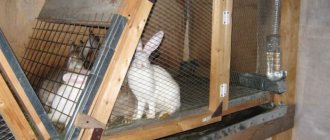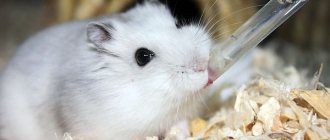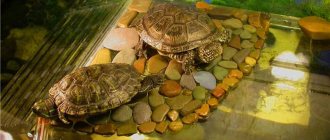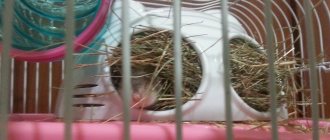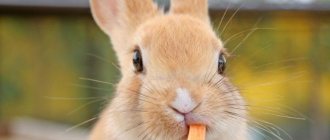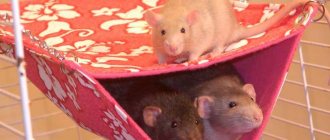Zolotukhin cell
Another inventor who made a huge contribution to the development of rabbit breeding is farmer Nikolai Zolotukhin.
He is the author of the method of breeding animals on a solid floor in a multi-tiered cage. In each compartment in the back, which is most often a latrine for rabbits, there is a mesh strip with a strip of 10-20 cm. Thanks to this, you can clean the cage once every few days or even weeks.
On a rigid base, rabbits feel much more confident and comfortable than on a mesh or slatted base. They gain weight quickly and get little sick. Anyone can make a Zolotukhin cage. The floor is made of flat slate. It is quite warm, durable and moisture resistant. There is no queen cell as such - before breeding, a board and a bedding of hay are placed inside. The mother rabbit makes her own nest and raises her young there.
Maintaining Zolotukhin’s mini-farm is quick and easy. The feeder, suspended from the door, can be easily turned over and cleaned thanks to the hinged mount. The floors are swept with a brush or broom. For drinking, you can use an inverted plastic bottle with a cap with a nipple inserted into it.
Construction requires inexpensive materials - boards, slate, galvanized mesh, plywood, OSB.
Home care and cleaning
In order for the house you created with your own hands to remain in its original form longer, and for the animals to be healthy and not get sick, you will have to do cleaning every day, removing leftover food, feces and soiled hay from the floor (if it is used as bedding or simply fell out of the hay barn and was trampled on by animals). Drinkers and feeders can be washed once a day, and the filler in the tray can be changed once every few days. Remains of dried urine on the floor and walls of the house can be removed using a vinegar solution (just soak a soft cloth in this solution and walk over all surfaces).
Important! No synthetic products are suitable for cleaning a rabbit house, since all of them are characterized by harmful fumes and can greatly harm the health of a sensitive animal.
General cleaning of a rabbit's home is usually done once a week. It involves a more thorough cleaning of all surfaces, possibly using a hot iodine or chlorine solution. The rug must be removed from the floor, washed and dried, then the feeder, drinker and hay box must be removed and boiled. Toys that can either be boiled or treated with a pet-safe disinfectant solution also deserve special attention.
Photo report on the manufacture of a cage for a rabbitry from a galvanized profile
This option is suitable for those regions where wood is expensive or for those who have a lot of profile remains after construction/repair. When making cages, the dimensions are adjusted to the existing molding - small deviations in one direction or another are acceptable, but the rabbits should have room in the cage.
Frame assembled
This cage was built for a female with rabbits up to 20 days old. It consists of two sections. The main part is 55*75*55 cm, the mother liquor is 35*55*30 cm. The racks have a reinforced profile, the crossbars are used for normal work - as usual with drywall - the pieces are fastened with self-tapping screws (fleas).
Example of profile fastening
The floor in the main part is made of a block 2 cm thick and 5 cm wide. The planks are attached to the profile with self-tapping screws. The screws must be screwed in so that they can be easily unscrewed - if (or rather, when) the strip is chewed, it will be easy to replace with a new one.
The floor in the main part is cracked
In the queen cell the floor is solid, without cracks. If in winter you are not sure that your rabbitry will be warm enough, it is better to make a double floor in this part and fill the gap with insulation - even expanded clay. In this case, even with a sharp cold snap, the babies will not freeze - their mother usually warms them from above. If it is warm from below, they will not get sick.
The mother liquor is made without cracks
The height of the queen cell is 20 cm lower than the main cell. From the inside, in the cage, there is a shelf on which the rabbit will escape from the annoying little ones.
Everything is covered with plywood, view from the side of the cage
To prevent the external joints of the plywood from being chewed, we cover them with perforated metal corners. You just need to look for the ones that are thicker. We cut the edges of the corners at 45° so that they do not ride up or stick out.
All that remains is the covering of the main walls and the manufacture of the door. This is what should happen as a result
All-season rabbitry
This option is suitable for you if you live in a cold area and the natural climate does not allow you to normally keep rabbits. Then, it’s worth insulating your rabbitry, making it out-of-season and suitable for any temperature.
Remember that the extreme temperature at which rabbits can be kept is -5C. If the temperature outside is lower, then you do not need to start raising rabbits until you have insulated the cage.
The easiest, but most expensive method is to purchase a special heating element powered by electric current. If there is no normal voltage outlet near the cage, then you should use a transformer.
After construction is completed, you can compare your cage with photographs of finished rabbit hutches. The main thing is to work hard and you will have a good rabbitry.
Making a house for a rabbit with your own hands
To make keeping a decorative rabbit at home comfortable for your pet, let’s look at how to make a house out of cardboard and wood.
Construction out of a box
This design has a short service life and is not suitable for permanent use. Typically, temporary housing is made from cardboard.
To create a house, you need to take a box measuring 600x300x400 mm. For larger individuals, you can connect 2 boxes so that the pet has room to roam.
To make the design you will need:
- 2 cardboard boxes 30 cm high and 50 cm long;
- pencil;
- scotch;
- scissors;
- compass.
Step-by-step instructions for making a rabbit house:
You need to take one box, determine the place where the entrance for the pet will be, using a compass and pencil, draw a semicircle - the border for the future entrance/exit. If you do not cut out the completely outlined borders with scissors, you will end up with a threshold at the bottom. The same holes must be cut on 2 more sides, leaving only the back wall intact. The top of the structure must be taped with tape so that the structure is stable and does not wobble. The same manipulations must be done with the second box.
It is important to take into account that the internal boundaries coincide. After all the preparatory work has been done, it is recommended to connect the 2 boxes together and glue them with tape to create a solid house. To somehow diversify the unsightly brown appearance of the structure, you can cover the house with wallpaper where a pet rabbit lives, or paint it with gouache.
The house made from boxes is an oblong dwelling with 2 central entrances and 1 side entrance. You can install a feeder and drinking bowl inside the structure. It is advisable to place a waterproof mat or hay at the bottom.
Making a wooden rabbit house
Taking into account the fact that rabbits love to gnaw on everything that is within their reach, a wooden structure will be the most durable. Thanks to its attractive appearance, the structure will fit into any design and will be an excellent house for decorative rabbits. If there are several pets, you can make houses in several tiers. Such a dwelling is called a shed.
Structures made from smooth and intact wooden boards look beautiful. If such a building material is not available, it can be made from chipboard plywood, mesh, and wood profiles. No knowledge of carpentry is required for manufacturing; even a beginner can make such cages.
In addition to the basic materials for work, you should prepare:
- self-tapping screws;
- nails with large heads;
- hinges on the door;
- sheet of tin measuring 60x100 cm;
- chipboard, plywood;
- mesh with small cells, galvanized;
- hammer;
- strips of wood;
- long straight scissors.
To make a house for a domestic rabbit, you must follow the steps of work:
- A rectangle measuring 60x100 cm should be cut out of plywood or particle board. A similar element should be made of tin. Fasten the resulting rectangles together using self-tapping screws. These elements will serve as the floor.
- For the walls, you need to cut 4 rectangles: two with side dimensions of 50x60 cm, two more - 50x100 cm.
- Now you need to mark the border of the window and doors with a pencil. The elements need to be cut out with a file.
- It is necessary to fasten the walls with nails, and screw the floor to them using self-tapping screws. To make it more convenient to connect elements, you can use metal corners.
- Window openings should be covered with fine mesh, which should be secured with small nails with large heads.
- It is recommended to make the door from wooden slats and mesh and secure it with hinges. To prevent rabbits from opening the door, you need a hook.
- All that remains is to make the roof. The structure can be gable or flat. The first is attached with nails, the second is removable.
The house is ready, all that remains is to install drinking bowls and feeders. You can put toys for a decorative rabbit.
The stairs can be made from the remaining pieces of particle board and wooden slats. The jumpers between the slats must be at least 4 cm. The outside of the home can be painted.
You can make a house for rabbits at home, even without the help of specialists. The most difficult moment in creating a home for a pet is the correct calculation of the dimensions. A manufactured house in all respects will be the key to the good health of a small pet.
When manufacturing, it is important to take into account this point; it is necessary to make the structure so that it can be easily removed
Housing requirements for rabbits
Regardless of what kind of rabbit you are preparing a house for (a dwarf decorative or an ordinary large one), there are a number of general points that should definitely be taken into account when developing the design. First of all, these include:
- The optimal size of the structure is so that the animal can freely fit in it and even straighten up to its full height (if there is no room for such a structure, you will have to build a smaller house, but with the condition of regular walking of the pet).
- Calculation of design parameters “for growth”. For a baby rabbit, the size of his house should be at least 4 times larger than its actual parameters, of course, if you do not want to remodel the home in the future. Standard shelter dimensions for representatives of dwarf breeds: 140*80*50 (L/W/H).
- Selection of quality materials. Any rabbits are very sensitive to toxic substances, so when choosing raw materials it is better to give preference to clean, unvarnished wood.
- Arranging a mesh floor (necessarily with small cells) or installing a special tray for excrement, covered with a hard mat (its corners should be bent in advance so that the animal does not injure itself).
- The height of the structure: either for the full height of the animal (its height is measured in a standing position), or taking into account the number of tiers (for two-story structures, the height of each floor can be reduced by 40 cm).
- A place to install feeders and drinkers (it is important that they can be fixed well and not tip over).
Important! You should not handle animals immediately after eating. After just 5-10 minutes, all the food can come out in the form of excrement, which will stain not only clothes, but also carpet or furniture (for this reason, animals are not allowed to walk around the apartment at this time).
Carrying out disinfection treatments of cells (care)
For a long time, harmful bacteria can live in bedding materials and wooden cage structures, as well as in food and water containers and equipment. If you regularly clean the room, this will give only 40% success in destroying microorganisms: the remaining ones will find a new refuge in a hard-to-reach place.
With the development of various diseases, even if it is diagnosed on time and treatment has begun, all these measures may not lead to a positive result until all cages, objects in it and inventory tools are completely disinfected.
Treating cells with a blowtorch
Most experienced rabbit breeders agree that rabbit cages must be disinfected once every 6 months, regardless of the number of animals kept on the farm. The best time for such work is spring or autumn. Unscheduled processing can be carried out at any time if there are prerequisites for this.
It is mandatory to carry out disinfection in the following cases:
- placing young animals with adults;
- upcoming birth;
- eliminated infectious or other disease.
Most viruses and bacteria are very viable, and to successfully fight people often resort to radical methods:
- Treatment with chemicals. This includes strong antiseptics. Used for external and internal parts of cells, they must be washed off with water.
- Aerosols containing chemical components. Similar to the method already described.
- Burning with fire. A blowtorch or gas torch is used.
- Car wash and using Karcher.
- Construction hairdryer.
Disinfection can begin only after the premises have been thoroughly cleaned. If you follow the following sequence, the work will not seem so difficult and impossible:
Transplantation of animals to another room or temporary cages. The cage is cleared of feeders, drinkers and other removable parts. Using equipment, bedding materials are removed, stored in plastic bags and then disposed of. It is imperative to inspect the cage for damage, holes in the walls, ceiling or floor. If there is damage, it must be repaired.
Using hot water, all contaminants are removed; it is important to thoroughly clean dried feces and food particles. If necessary, use a stiff brush. The cage is washed both inside and outside, then detergents can be used
After washing off such products, the cage should be dried in a room with good lighting. All components of the drinking bowl and feeder removed from the cage are also thoroughly washed; it is important not to forget about the inventory tools. While everything is drying, general cleaning is carried out in the room where the cages were. Hot water and detergents are also used here
The cage is washed both inside and outside, then detergents can be used. After washing off such products, the cage should be dried in a room with good lighting.
All components of the drinking bowl and feeder removed from the cage are also thoroughly washed; it is important not to forget about the inventory tools. While everything is drying, general cleaning is carried out in the room where the cages were
Hot water and detergents are also used here.
We invite you to join our group on VKontakte or Odnoklassniki, where new articles are published, as well as news for gardeners and livestock farmers.
Types of rabbit hutches
Rabbit hutches come in many different types. From the simplest rabbitry to the most exotic and original.
We will tell you about the main and most common rabbitry:
- Rabbit hutch in a hole
- All-season
- Mini farm
- Group cage
All these types are quite popular among farmers. We will tell you and describe each type in every detail.
Necessary materials
First of all, you should decide on the size of future cells. The most common option is a double design, which has two separate sections.
There are other types of housing:
- single-section;
- group (for young animals);
- with three sections;
- with mother liquor.
The photo shows standard single-section cages for adult animals.
Creating any structure for keeping rabbits involves step-by-step production of the frame, floor, walls, ceiling and door, followed by assembly. In most cases, wood and metal mesh are used in construction. Therefore, for work you will need the following tools and materials:
| Tools | Materials |
|
|
Before you start designing, you need to acquire all the necessary tools
The wood should first be sanded and thoroughly sanded, and the ends of the mesh should be securely fastened. All sharp edges must be removed, otherwise the animal may be injured. It makes sense to cover wooden surfaces inside the home with tin to make the enclosure more durable, since rabbits love to gnaw on everything that catches their eye. Thick wooden beams are usually used for the main frame, and the walls and ceiling are made of plywood sheets and mesh. Note that if the rabbits’ home is located outdoors, then the length of the legs of the frame should not be less than 80 cm. For cages placed indoors, 30-centimeter legs will be enough.
If the enclosure will be located in the open air, then it is important to pay special attention to the construction of the roof of the home. Direct sunlight, precipitation and drafts negatively affect the well-being and health of animals. It is not recommended to make a roof out of metal - it gets very hot in the sun, which can lead to heatstroke in a rabbit
It is better to cover the top of the structure with slate
It is not recommended to make a roof out of metal - it gets very hot in the sun, which can lead to heatstroke in a rabbit. It is better to cover the top of the structure with slate.
Common designs and their features
Livestock specialists and amateur rabbit breeders have developed many models of cages for keeping rabbits. The most common designs of rabbit hutches are:
- single-section cage;
- design with two sections;
- rabbitry with queen cell;
- three-section (family type);
- solid wire;
- Mikhailov mini-farm;
- Zolotukhin cells.
The most successful and simple design that can be repeated with your own hands can be considered a two-section one.
Two-section cages are very convenient for keeping rabbits
To save space, the cages are installed in several tiers, forming a so-called shed. This design saves material and makes caring for animals easier. It is this system that is used in the designs of rabbit hutches by famous rabbit breeders Mikhailov and Zolotukhin.
A double cage with a queen cell (feed compartment) is used to place the female rabbit during birth. In the form of a queen cell, a removable type nesting box is used - newborn rabbits are kept in it until they reach one month of age. Between the food compartment and the main part of the cage, a hole measuring 20x20 cm is arranged.
At the time of giving birth, the female is placed in the queen cell. It is often done in an ordinary cage, setting up a closed compartment with a hole
All-wire rabbitries are convenient for mass breeding or on farms. Along with the advantages of simplicity and ease of maintenance, such cages also have a significant drawback - they require a separate room for installation.
In a family-type cage you can place two females with young animals or two individuals of different sexes. The compartments between the compartments are made of mesh, slatted or solid wooden partitions.
Single-section cages, although they are the simplest to manufacture, are practically not used in private farmsteads due to the low hygiene and aesthetics of the structures.
Before starting the construction of a rabbitry, they prepare the tools and materials that will be needed for the work, and also take the necessary measurements and draw up drawings of the future structure.
Step-by-step manufacturing instructions
Let's take a step-by-step look at whether it is possible to correctly assemble and build a multi-tiered structure for breeding rabbits at home.
To install the frame, the purchased boards must be divided into several parts of the following sizes: 4 pieces (100x30x2250 mm); 12 pieces (50x30x1340 mm); 12 pieces (50x30x540 mm); 72 pieces (25x30x540 mm). From the resulting parts you need to assemble 6 identical frames with dimensions of 1340x600 mm. Installing them is not difficult at all. First, one is made with precise angles, and then it is adapted as a template for creating others. To assemble one frame you need 2 beams with dimensions 50x30x540 mm and 2 beams with dimensions 50x30x1340 mm. The smaller ones are attached between the larger ones using self-tapping screws. Next, 6 frames with the smaller side must be placed on boards with dimensions of 100x30x2250 mm. The distance from one frame to another is 400 mm. It is necessary that 180 mm remain between the tiers, and the first tier must be raised from the ground by 400 mm. Self-tapping screws are used for fastening. Now you need to place two similar ones parallel to these two boards on the other side of the frame
It is important to make sure that they stand perfectly level, which a building level will help you with. Next, we select bars with dimensions of 25x30x540 mm. We use them to construct a floor in the form of a lattice.
The distance between the two bars should be about 20 mm. They are mounted inside each frame, and secured on the outside with self-tapping screws. Each of the tiers must be divided into two different cells. The partition will be a hay box that resembles the letter V. It is necessary to lay down food for rabbits: hay or grass. The frame of the hay barn needs to be stitched inside along these installed bars using a mesh. If it is planned to arrange a queen cell on one of the tiers, then the floor must be level, without gaps, as mentioned above. A sheet of plywood will serve as a barrier from the main part of the cage to the queen cell, but it is important to ensure that this “door” opens freely, which can be done by installing additional bars. The entrance from the rabbitry to the queen cell can be in the shape of a circle or semicircle, but it is important that it is located 100 mm above the floor so that the cubs cannot move into the cage until they learn to overcome such a barrier themselves. In the queen cell you need to make a bottom from a plywood sheet, but do not nail it to the bars, so that you can then freely remove it and dry it before the next breeding. It is necessary to make a hinged door on top, securing it to the hinges and providing a lock in the form of a latch. Next, in accordance with the remaining openings, it is necessary to make frames for caged doors, constructing them according to the same principle as frames for tiers. The mesh can be secured to any frame using a construction stapler. The choice of the side where the hinges for the doors will be attached depends solely on the preferences of the owner and the conditions in a particular room. You can install them from the bottom, and the door will be hinged, or you can mount them on the side, and it will be hinged. Depending on the external conditions, the cage frame can be lined with metal mesh or plywood. It is extremely important to provide a system of ebb tides so that waste from the tiers located above does not reach the animals living below. To do this, you need to attach a metal sheet with sides bent by 100 mm to the front lower part of the tier. The ebb is located at an angle and extends beyond the cage by approximately 30 mm. Consequently, it turns out that all waste is sent back, which allows easy access to the front side of the cells.
This construction option is quite simple, construction will not take much time. The result will be an excellent single-tier or multi-tier (as you wish) cage.
Mini farm
A mini-farm is the most convenient and practical cage for rabbits. Although it is not very easy to do. Experienced farmers spend months building such a cage.
The rabbitry itself is quite large. It can accommodate up to five dozen rabbits. Also, a mini-farm implies full automation and mechanized supply of water and food.
If you are new to farming, we do not advise you to use this method, as it requires large financial investments.
Cell sizes
It is necessary to correctly determine the dimensions before you start making a cage for rabbits with your own hands; the drawing should be based on them. One cage is not enough if you plan to breed rabbits. It is necessary to build three or four internal sections at once. If you place all the animals in one area, then it will be very uncomfortable for them to live together, and various problems will arise during breeding.
Approximate dimensions of a standard cage:
- Length - 140 cm.
- Width - 80 cm.
- Height - 50 cm.
If the rabbits are still very young, then 90 cm is enough length, but it is better to leave the other parameters the same. One adult rabbit requires 0.7 square meters. m of free space. For a young person, 0.2 square meters is enough. m, but no less!
There are several types of cages for rabbits:
- For young animals.
- For adults.
- For a female rabbit with offspring.
- For large breeds (“giants”).
You can assemble all these rabbit cages with your own hands.
Room for young animals
Growing rabbits must be separated from their mother and kept in groups of 10-20 individuals. For them you will need to assemble a cage with a total area of 30 by 100 cm, a height of 50 or 60 cm.
The floor must be made of thin wooden slats, previously covered on the side with a metal mesh. The cells must be small so that rabbits cannot get out through them. You can also make a mesh floor, but you will need to provide a separate warm room where the animals can warm up.
In winter, the entire structure should be well insulated with straw and hay. Many farmers simply do not want to provide separate housing for the younger generation of rabbits, so they place them in cages that are intended for adult varieties. In this case, it is necessary to calculate how many animals can be placed in one cage so that they feel comfortable. If the house is too small, an additional one will be required.
For adults
For an adult rabbit, the cage depth should be 70 cm, height 60 cm, and length at least 1 meter. Here it is necessary to use a block design, and each block is divided into two sections by a grid. During the mating period, the grate should be removed so that the two sections become one space.
You can make a three- or two-tier cage. This design will be somewhat more complicated, but this way you can save space on your site. It is necessary to prepare a separate place in the cage for sleeping, walking and eating. For this purpose, structures at a distance of 15 cm from the floor are separated by a plywood partition, which has an opening of 20 by 20 cm. The sleeping compartment is equipped with a wooden door, and the place for eating and walking is equipped with a mesh door.
House for a rabbit
It is recommended to build a separate house for a female rabbit with her offspring only for the winter period. When setting up, remember that the female will be nervous in a cage fenced with a mesh, and this will have a bad effect on the offspring. The house must be closed so that the mother is confident in the protection of her offspring, but a house made of mesh will not give her such confidence. Only the front wall can be made from mesh. The cage needs to be well insulated.
The frame is made from good timber, the back and side walls are made of plywood. The cage must be immediately divided into several sections: a large one where the rabbits will walk, and a small one for the nest. Doors must be made for each compartment. The walls and floor must be made double, according to the sandwich principle. Straw and foam plastic are laid between them for insulation. The roofs are covered with any slate.
Aviaries for large breeds
Giant rabbits are very large varieties, so their home must be much larger than for ordinary rabbits. Adults grow up to 60 cm in length and can reach a weight of 8 kg.
Minimum house sizes for one rabbit:
- Height - 65 cm.
- Length - one and a half meters.
- Width - 75 cm.
These parameters can even be increased to make the rabbit feel comfortable inside. For a young rabbit, it is necessary to build a group cage with a height of 50 cm and an area of 1.2 square meters. m. The weight of the animal will be quite large and the floor needs to be well strengthened. It is also best to use galvanized mesh, but thicker. To prevent the floor from falling through, the sheathing underneath must be made of bars, which are located at a distance of several centimeters from each other.
How and what to decorate the house inside
A wooden or cardboard house made according to the scheme described above is just a box with holes, which still needs to be properly decorated from the inside for the pet’s convenience. If you are going to keep decorative rabbits in the house, then the floor of the rabbitry can be covered with bamboo fiber or other dense, but at the same time soft material. In one of the corners it is worth leaving a place for a toilet, covering the surface with moisture-absorbing fabric or simply installing a tray (many domestic rabbits almost immediately understand what exactly it is for). In two-tier structures, space for the toilet can be allocated under the stairs.
Did you know? The mother rabbit feeds her children no more than 10 minutes a day, so not all the cubs (and there are up to 15 or even 20 of them) survive and develop normally.
It is also worth taking care of good fixation of drinkers and feeders, and preparing a place for a hay barn in advance. It is advisable to not raise the drinking bowl too high so that your pet does not have to reach for it. Feeders can be purchased ready-made and simply attached to the walls using the included fasteners.
A piece of large rope, cardboard tunnels, or even cotton balls can serve as toys, although none of them will last for a long time. Sturdier toys specifically designed for little ears can be purchased at a specialized pet store.
Materials
The amount of material is calculated based on the number of buildings and drawing calculations. For the design you need:
- Beams, slats, planed boards, plywood;
- Mesh for walls, partitions, floors;
- For the roof - roofing felt, tin, slate;
- Latches, door hinges, portable handles;
- Self-tapping screws, nails.
Standard carpentry tools are suitable. If more complex work is involved, involving welding and cutting, then it is better to seek help from knowledgeable people.
- Types, applications and characteristics of paving slabs
- Is a land plot required to be inspected before purchasing it?
- What models of corner sofas exist: how to quickly navigate through the variety of models and colors
Rules for choosing a place for a rabbitry
Before you make a rabbitry with your own hands, choose a place for it. And this is regardless of whether a large farm is being built or several cages are installed. The choice of location is based on building regulations. They state that buildings in which animals or birds are kept must be within 40 m² in area and be at least 15 m away from the main house.
Quite recently, our website published a detailed post on how to make a chicken coop for 10-20 chickens with your own hands; at the end of the article there is a detailed photo report on the work done by our reader, follow the link if you have not read it yet.
The remaining requirements for the installation site of the rabbitry are as follows:
- there should not be high humidity on the site, optimally an elevated place;
- minimal influence of wind, so the rabbitry is built as a room or impenetrable fencing structures are installed;
- on the site, groundwater should not lie higher than 1.5 m (you can check this yourself by drilling a well with a garden drill);
- the soil should not be dense and clayey so that rain or melt water does not linger on the surface;
- A quiet place is the key to the health of the animals.
Attention! If there is no such place in the suburban area, then choose the one that would best meet the requirements described above. Minor deviations can be neglected.
Collection rules
In order for the animals to be as comfortable as possible in the manufactured house, it is necessary to follow certain rules during construction. It is advisable not to violate them:
- The protruding parts must be covered with tin.
- It is advisable to use slate for the roof.
- Under no circumstances should you use varnish or antiseptic for impregnation; rabbits will not like the smell.
- An extremely durable wooden beam is used as a frame.
- The back walls can be made of plywood.
When the drawing is completed and the materials are prepared, you can proceed to the actual construction. First of all, the frame is assembled, and then the mesh floor is laid.
If outdoor maintenance is planned, then the floor is insulated and a removable tray is installed underneath it. This is necessary for cleaning. Next, you can install the back wall, which is made of plywood. It is worth noting that it must be lower than the front one. The side walls can also be made from a sheet of plywood.
If the cage is planned to be double, then a hay barn is installed in the middle. The last wall is made of mesh, with a door. If the cage will always be outdoors, then it is necessary to properly insulate the sleeping compartment. It is advisable to make the roof at an angle and then cover it with slate. This is necessary to prevent water from accumulating on the surface after rain.
The contents of the cages may differ; it is chosen depending on what kind of rabbits will live there. For small rabbits, you need to install special queen cells, as well as nesting compartments. If there is group keeping, then a well-heated nesting room should also be arranged.
Before starting assembly, you need to decide on the place where the structure will stand. The place should be comfortable and protected from draft winds. In no case should you place a house for a rabbit on the south side, since there the animal will suffer greatly from the extreme heat. If the house will stand on the street all year, then the floor must be made in such a way that it slides out like a pallet, with a lathing of slats placed on top of it.
If you take into account all these nuances, then making a cage for a rabbit will not be difficult.
Beginning of work
Between the idea of building a rabbitry and its implementation stands the most important design stage. You must study the features of keeping long-eared pets and make the house as comfortable as possible for both the animals and the person who will look after them. Always remember that rabbits are living beings with their own needs.
Having decided on the breed, plan further livestock. The size of the animals, their gender and age make adjustments to the design of the rabbitry. When starting construction, it is better to provide for the possibility of further expansion.
Choose your location carefully. Try to find an area away from sources of loud noise. Give preference to the shady side and elevations: in summer the sun will not cause discomfort to the animals, and in rainy weather water will not flow into the rabbitry. Under no circumstances should it be adjacent to a compost pit.
Nothing should block access to the cells. They themselves should be as spacious and comfortable as possible.
Useful tips for keeping rabbits
Decorative rabbits are quite capricious creatures, which in their pampering are superior to even their larger relatives. They respond painfully to any changes in the microclimate and are very sensitive to low-quality food, therefore, in addition to home improvement, it is also worth knowing about the rules for caring for these fluffies.
Here are some of the most common recommendations:
- Place the cage with the animal only in a room with a constant air temperature within +18...+22 °C and a complete absence of drafts.
- Make sure that other pets (especially cats and dogs), as well as small children, do not have access to your long-eared pet, because they can not only stress him out, but also cause physical harm.
- Never pick up a rabbit by the ears or the withers: this causes significant discomfort and can even frighten him.
- Always maintain the temperature within optimal limits, avoiding overheating of animals (this harms them even more than lower temperatures). As a last resort, if there is no other suitable place in the room, and the sun's rays fall on the cage, cover it with a damp towel and regularly wipe the animal's ears with a clean, cold, damp cloth (there should always be drinking bowls with cold water or even ice in the cage itself) .
- When ventilating the room, it is better to temporarily move the rabbit to another room, placing it in the coolest corner.
- If you don't have time to completely clean the cage, at least clean the toilet to avoid toxic buildup.
- Organize walks for the animal around the apartment every day, and in the summer, take it out into the yard more often, only mainly in the evening (these nocturnal animals can sit quietly in a cage all day, becoming more active only with the arrival of night).
- Do not restrict the animal’s movements, otherwise it will begin to quickly gain weight and soon become obese, which will negatively affect its overall well-being.
- Long-haired pets will have to be additionally combed and their hair trimmed periodically to prevent it from matting.
- As they grow, it is necessary to trim the animals' claws, for which special nail clippers are designed.
- To feed your furry pets, choose only high-quality food, possibly containing probiotic substances (prevent the development of problems with the animal’s stomach). In addition to dry mixtures, it is useful to give rabbits an apple, a pear (in limited quantities) and vegetables prepared in the summer.
Building a rabbit house is not as difficult as many people think, but whatever option you choose, do not forget that this is just the beginning of your mission.
For a comfortable life in it, the animal will need appropriate care, the basic rules of which you already know. https://fermhelp.ru/kak-sdelat-domik-dlya-krolika-svoimi-rukami/https://stroy-podskazka.ru/kletki-i-domiki-dlya-krolikov/vybor/https://fermer. blog/bok/zhivotnye/kroliki/soderzhanie-krolikov/447-kak-postroit-i-obustroit-domik-dlya-krolika.html
Features of caring for rabbits
There is a common belief that rabbits are prone to various diseases. And if one individual gets sick, the entire population will inevitably die. Hence the reluctance of farmers to breed rabbits. There is a high risk of losing all animals at once and incurring losses.
Experts believe that proper maintenance of rabbits, together with well-chosen balanced feed, reduces the risk of loss of livestock to zero. When well maintained, these rodents reproduce quickly and grow well.
Having decided to start breeding rabbits, you must first take care of the conditions in which the animals will live. A proper rabbitry should be convenient both for rabbits to live in and for caring for.
Types and sizes of cells
There are many options for housing rabbits. Each type of design has its own characteristics, advantages, disadvantages and purpose.
A cage for keeping a pregnant rabbit with young animals must be equipped with a nest. Nest Building Basics:
- A window in the box is cut at a height of about 10 cm from the floor so that the cubs do not fall out and get out.
- The floor in the cage is solid.
- To prevent a nest made of plywood from rotting, you should cover the bottom with an iron sheet and sprinkle it with a thick layer of hay.
- The nest should have an opening lid.
- Take care of heating the room if the temperature is lower than recommended (for example, install an infrared lamp in a special box).
Two-section and group cages are suitable for keeping two or more individuals at the same time. Group housing is used for young animals up to six months of age. If aggression appears on the part of one of the rodents, the individuals should be seated.
Interior arrangement of the house
After completing the construction work, you can start working on the interior arrangement of the house. You should start by checking the safety of your flooring. The bottom should be covered with a rug made of environmentally friendly materials, such as cotton or bamboo fiber.
It is strictly forbidden to use wool or carpet products as bedding. In this case, the rabbit may die due to disruption of the digestive tract, since it tastes everything that is within its reach.
A thick layer of bedding should be laid on the rug to protect the animals' paws from bedsores. Large straw or sawdust or hay from awnless crops are suitable. The thickness of the bedding for adults should be at least 15 cm.
You should not choose fine straw as bedding for the bottom. In summer, only the floors in the houses of pregnant females need covering.
In the new home, it is necessary to install a feeding trough and drinking bowl so that they cannot become clogged with feces. Special purchased feeders that are attached to the cage will help prevent this outcome. Drinking bowls should be placed low so that the animal can reach them. They can also be placed along the edges to prevent animals from getting their paws into them.
It is worth taking care of the place for the toilet. Usually it is located under the stairs if the house has a two-tier structure.
If the home was equipped for a decorative rabbit, you can also put toys made from natural materials in it. These can be various balls, cardboard tunnels and large ropes. Similar toys are sold at any pet store.
Types of designs
On the Internet you can find a lot of information, as well as photos of ready-made rabbit hutches, after studying which you can choose exactly what suits your taste and budget allows.
They are:
- Open. It is more popular due to the fact that its size can vary and will allow up to one hundred individuals of this species to live in it, and is easy to use.
- Closed. Due to the fact that this type of structure is placed in a finished building, such as a barn, the number of pets will be limited due to the minimum housing space.
If you are building a new rabbitry, you can consider the following options: single or multi-section structures.
Tame rabbit
As a rule, domestic rabbits get used to being handled faster than those living outside, since they communicate with people constantly. Plus, you won't have to run out into the cold to feed your rabbits and clean their hutch.
When it comes to your rabbit's health, living indoors should not cause any problems for him, provided that his diet contains enough vitamin D and calcium, and the diet itself is based on hay with the addition of store-bought dry rabbit food. If you have a garden, no one is stopping you from letting your rabbit out for a walk from time to time.
Domestic rabbits are usually tame and affectionate.
Photo gallery
Photo 1. Two-story cage with pets
Photo 2. House with a greenhouse
Photo 3. Outdoor enclosure for rabbits
Photo 4. Place for the rabbit to play
Photo 5. Funny little eared house
